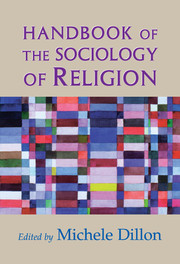Book contents
- Frontmatter
- Contents
- List of Contributors
- Acknowledgment
- Part One Religion as a Field of Sociological Knowledge
- Part Two Religion and Social Change
- 6 Demographic Methods for the Sociology of Religion
- 7 Church Attendance in the United States
- 8 The Dynamics of Religious Economies
- 9 Historicizing the Secularization Debate
- 10 Escaping the Procustean Bed
- 11 Religion and Spirituality
- Part Three Religion and the Life Course
- Part Four Religion and Social Identity
- Part Five Religion, Political Behavior, and Public Culture
- Part Six Religion and Socioeconomic Inequality
- References
- Index
6 - Demographic Methods for the Sociology of Religion
Published online by Cambridge University Press: 05 June 2012
- Frontmatter
- Contents
- List of Contributors
- Acknowledgment
- Part One Religion as a Field of Sociological Knowledge
- Part Two Religion and Social Change
- 6 Demographic Methods for the Sociology of Religion
- 7 Church Attendance in the United States
- 8 The Dynamics of Religious Economies
- 9 Historicizing the Secularization Debate
- 10 Escaping the Procustean Bed
- 11 Religion and Spirituality
- Part Three Religion and the Life Course
- Part Four Religion and Social Identity
- Part Five Religion, Political Behavior, and Public Culture
- Part Six Religion and Socioeconomic Inequality
- References
- Index
Summary
The sociology of religion may not overlap with demography in many people's minds, but two facts about the past one hundred years of American religion indicate how demography helps shape the religious landscape. Fact 1: Most people practice the religion their parents taught them. That means that the principal factor in the changing religious composition of any given society (and of the United States in particular) is the number of children each adult has to teach, that is, the relative fertility rates of different religions (Hout, Greeley, and Wilde 2001). Fact 2: Most people who have switched from one religion to another have switched from their parents' religion to their spouse's religion. That means that the prevalence, timing, and selectivity of marriage also affects the distribution of people across religions. In this chapter, I will lay out some of the demographer's concepts and methods that have the greatest utility for the sociologist of religion.
To motivate attending to the details, however, let us consider a “thought experiment” – not a flight of fancy, something close to the way societies are organized. Imagine a country that has two religions, one larger than the other. Imagine further that, over time, the minority religion grows faster than the majority one. To be realistic, it would be okay to imagine that the population as a whole grows and that both groups grow with it; the key condition is that the smaller one is growing faster than the larger one.
- Type
- Chapter
- Information
- Handbook of the Sociology of Religion , pp. 79 - 84Publisher: Cambridge University PressPrint publication year: 2003
- 5
- Cited by



